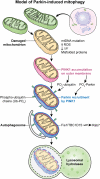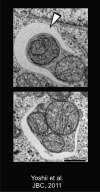The roles of PINK1, parkin, and mitochondrial fidelity in Parkinson's disease
- PMID: 25611507
- PMCID: PMC4764997
- DOI: 10.1016/j.neuron.2014.12.007
The roles of PINK1, parkin, and mitochondrial fidelity in Parkinson's disease
Abstract
Understanding the function of genes mutated in hereditary forms of Parkinson's disease yields insight into disease etiology and reveals new pathways in cell biology. Although mutations or variants in many genes increase the susceptibility to Parkinson's disease, only a handful of monogenic causes of parkinsonism have been identified. Biochemical and genetic studies reveal that the products of two genes that are mutated in autosomal recessive parkinsonism, PINK1 and Parkin, normally work together in the same pathway to govern mitochondrial quality control, bolstering previous evidence that mitochondrial damage is involved in Parkinson's disease. PINK1 accumulates on the outer membrane of damaged mitochondria, activates Parkin's E3 ubiquitin ligase activity, and recruits Parkin to the dysfunctional mitochondrion. Then, Parkin ubiquitinates outer mitochondrial membrane proteins to trigger selective autophagy. This review covers the normal functions that PINK1 and Parkin play within cells, their molecular mechanisms of action, and the pathophysiological consequences of their loss.
Copyright © 2015 Elsevier Inc. All rights reserved.
Figures







References
-
- Anderson S, Bankier AT, Barrell BG, de Bruijn MH, Coulson AR, Drouin J, Eperon IC, Nierlich DP, Roe BA, Sanger F, et al. Sequence and organization of the human mitochondrial genome. Nature. 1981;290:457–465. - PubMed
-
- Bender A, Krishnan KJ, Morris CM, Taylor GA, Reeve AK, Perry RH, Jaros E, Hersheson JS, Betts J, Klopstock T, et al. High levels of mitochondrial DNA deletions in substantia nigra neurons in aging and Parkinson disease. Nat Genet. 2006;38:515–517. - PubMed
Publication types
MeSH terms
Substances
Grants and funding
LinkOut - more resources
Full Text Sources
Other Literature Sources
Medical

